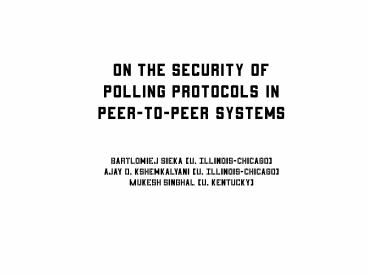On the Security of - PowerPoint PPT Presentation
Title:
On the Security of
Description:
P2P paradigm extremely popular (Gnutella, Chord, Napster, Freenet) ... Allows attacker to fabricate votes so as to appear to come from a legitimate voter ... – PowerPoint PPT presentation
Number of Views:38
Avg rating:3.0/5.0
Title: On the Security of
1
On the Security of Polling Protocols
in Peer-to-Peer Systems Bartlomiej Sieka (U.
Illinois-Chicago) Ajay D. Kshemkalyani (U.
Illinois-Chicago) Mukesh Singhal (U. Kentucky)
2
Presentation Plan
- Introduction
- Attacks
- Attack on the PollReply message
- Attack on the Basic Protocol
- Attack on the Enhanced Protocol
- Proposed Solution (to 23)
- Solution Discussion
- Conclusions
3
Introduction
- P2P paradigm extremely popular (Gnutella, Chord,
Napster, Freenet)... - ...but also challenging wrt security
- Critical issue dealing with strangers
- Solution keep track of others' behavior
(reputation, credibility) - Focus on GPP (Gnutella Polling Protocols),
published in TKDE (5).
4
GPP Gnutella Polling Protocols
- Phase 1 Resource Searching
- Phase 2 Polling
- Poll message
- PollReply message
- Phase 3 Vote Evaluation
- TrueVote/AreYou messages
- TrueVoteReply/AreYouReply messages
- Phase 4 Resource Downloading
5
GPP Overview
- Originator broadcasts a Poll message
- Peers wishing to respond to the poll (voters)
send back a PollReply message with their votes - Originator selects a subset of voters and
contacts them to verify their vote - integrity authenticity (in the Basic protocol)
- authenticity (in the Enhanced protocol)
6
GPP Details
7
PollReply Message Attack
- Broadcasting the public key to be used for
encrypting the PollReply allows the following
attack to be performed. - Alice broadcasts Poll(T, PK_poll)
- Mallory generates (PK_fake, SK_fake) key pair
and broadcasts Poll(T, PK_fake) - Mallory receives PollReply(EPK_fake(contents)).
He then decrypts the PollReply message with
SK_fake, encrypts it again with the original poll
key PK_poll, and forwards it to Alice
8
PollReply Msg Attack Discussion
- Attacker knows votes sent by original voter
- The originator can be made to discard unwanted
votes by tampering with the integrity check - Unwanted votes
- unfavorable for attacker or his friends
- favorable for node that attacker wants to harm
- Man-in-the-middle attack (victim proximity)
- Conclusion confidentiality in P2P is hard
9
GPP Details
10
Basic Protocol Attack
- Alice broadcasts Poll(T, PK_poll)
- Mallory forges suitable votes and using his IP
and port, sends to Alice PollReply(EPK_poll(IP,
port, Votes, h(IP, port, Votes)) - Alice receives PollReply sent by Mallory.If she
wishes to check Mallory's votes - she contacts him via (IP, port)
- she verifies the votes
- Note Mallory's servent_id stays undisclosed
11
Basic Protocol Attack Discussion
- servent_id associated with (IP, port) too late -
attacker can boost his reputation without
disclosing his identity - Requires attacker to disclose (IP, port), but
still feasible for dial-up connections and NAT'ed
machines - Vote evaluation phase does not prevent this (it
is the attacker being contacted in that phase) - Can be carried out over multiple polls
12
GPP Details
13
Enhanced Protocol Attack
- Alice broadcasts Poll(T, PK_poll)
- Mallory generates (PK_fake, SK_fake) key pair and
broadcasts Poll(N, PK_fake), where N?T - Mallory recvs PollReply(EPPK_fake(IP, port,
Votes, servent_id, SSK(contents), PK_i)Note
Votes contains only opinions about servents from
set N - Mallory decrypts the message and checks if the
votes are to his liking
14
Enhanced Proto AttackDiscussion
- Allows attacker to fabricate votes so as to
appear to come from a legitimate voter - Attacker can modify the set of peers for which
votes are expressed (can not modify the votes,
though) - Attacker can
- remove himself if his vote is unfavorable
- remove a colluding peer with an unfavorable vote
- remove a hated peer with a favorable vote
15
Proposed Solution
- servent_id is the hash of the public key
- (IP, port) is volatile (dial-up, dynamic IP DSL,
NAT), servent_id permanent - reputations are associated with the servent_id
- random numbers used for poll identifiers
- PollReply encryption tradeoffs
16
Proposed Solution cont'd
- Resource searching (Query/QueryHit)
- Polling (T set offerers we inquire about)
- Generate R and (PK_poll, SK_poll)
- Poll peers about T Poll(T, R, PK_poll)
- Receive votesPollReply(EPK_poll(R, IP, port,
Votes, PK, SSK)) - Vote Evaluation
- Send Verify(R, Votes)
- Receive VerifyReply(R, Votes, SSK(R, Votes))
17
Solution Discussion
- Votes vector has to have an entry ltofferer,votegt
for every offerer from T - Attacks thwarted by
- Voting accountability is gained by including (IP,
port) and servent_id (indirectly by PK) in the
PollReply - PollReply ambiguity is resolved by more strict
format of the Votes vector - Tradeoffs for PollReply public-key crypto
18
Conclusions
- Security improvements over GPP
- Security achieved thanks to
- digital signatures (integrity)
- public key crypto (confidentiality)
- random numbers for poll identification
- Open issues/future work
- lack of secure outside comm. channel
- fully self-organized approach
19
Thank you for your attention.































